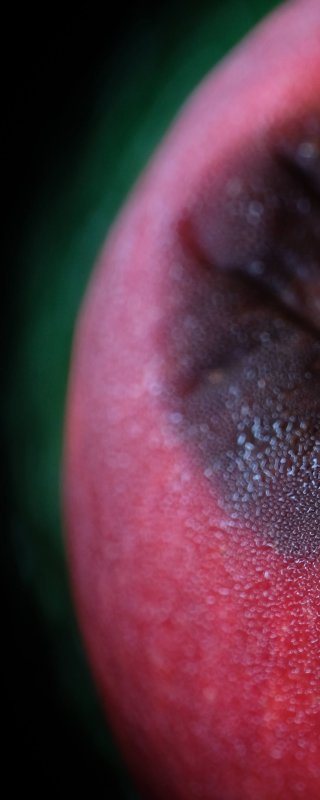
Apple rot caused by fungi
Apples can be affected by many different fungi. Here we give an overview of some frequently occurring rots caused by fungi.
Overview of rot-causing fungi in apples
-
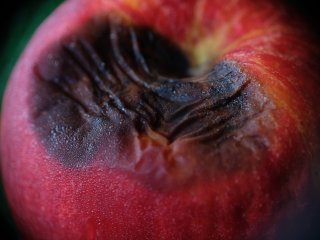
Alternaria rot
Alternaria rot, also called black rot, can be recognized by black spots on brown skin. These fruits can ultimately also become completely rotten and soft. The fungus can also attack via an open blossom-end of the apple. This fungus is common in connection with skin disorders such as 'soft scald' and 'sunburn'. -
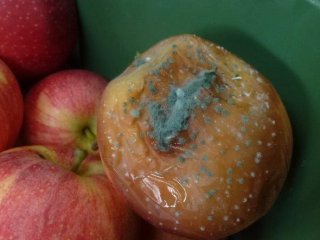
Blue mould
Blue mould is caused by the fungus Penicillium expansum. It is a soft watery rot that begins around injuries or lenticels on the skin. Later, greyish blue masses of spores may appear on the apple surface. The decayed tissue has clear edges and easily separates from healthy tissue. Injuries during picking or further handling are the primary access points for the fungus. -
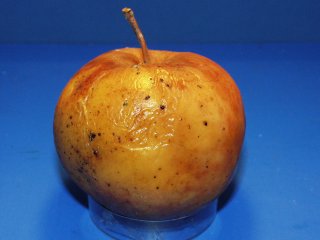
Botrytis rot
Botrytis rot, also called grey mould rot, starts with a brown discolouration around lenticels, wounds or the blossom-end of the apple. It is a soft rot (mostly). White-grey mycelium can cover the decayed area that is light brown to brown. The decayed tissue cannot be separated from healthy tissue. The fungus can form large nests of rot in stored fruit. Prevention of infection begins in the orchard. Proper harvesting and handling should limit infections that occur via wounds. -
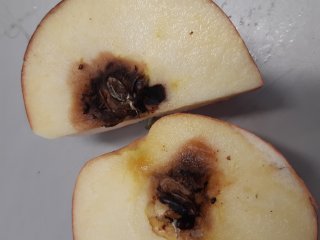
Core rot
Core rot is caused by fungi that cause diseased parts around the core. The rot can be soft and watery, but also dry and cork-like. It can extend to the stem and to the blossom-end of the apple. In that case it can become also visible from the outside. The infection has occurred in the orchard. -
Lenticelspot
Lenticelspot is a postharvest disease caused by the fungus Fibulorhizoctonia. The spots are centered on the lenticels. In later stages, it turns into larger rotten spots. The risk is greatest in humid places in the storage room. Therefore, sufficient air circulation through storage bins is recommended. Reducing lenticelspot requires a sufficient level of moisture loss over the storage period. -
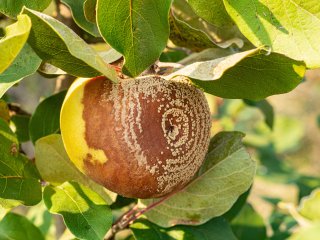
Monilia rot
Monilia rot (brown rot) is a firm rot. The first indication of infection is a small circular brown spot. Then white mould may appear. During storage, apples can turn completely black, while the skin remains shiny and unbroken. Prevention of injuries in the skin helps to reduce infection. -
Nectria (calyx) rot
Nectria rot (calyx rot) usually occurs at the blossom-end and stem-end of the apple. It can be recognised by a round sunken brown spot, with white mycelium in a later stage. The rot has a clear border between healthy and rotten tissue. This disease should be controlled in the orchard. -
Neofabraea rot
Neofabraea (formerly known as Gloeosporium) forms a circular firm brown rot. The centre of the circle may be lighter coloured than the edge. That's why this rot is also called bull's eye rot. The fungus may attack through a lenticel. The disease must be controlled in the orchard. Furthermore, storage conditions that slow down the ripening also slow down the onset of rotting. Consequently, this disease is usually found only after a storage period of at least several months. -
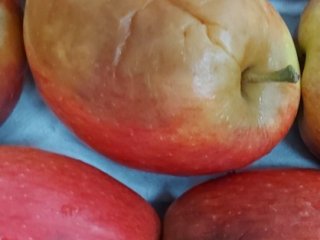
Phytophtora
Phytophthora rot is a firm rot with pale to mid-brown colour. There is no clear boundary between healthy and rotted flesh. The skin can easily detach from the fruit flesh. The apples have an unpleasant odour. The fruits are often originating from low hanging fruit in the orchard (where soil particles splashed up by rain). Also, fruits may have been infected during wet weather around harvest time, or during wet sorting. -
Stem-end rot
Stem-end rot can be caused by various fungal pathogens. The rot starts from the stem. Apples which are picked without stem can easily develop rots in the stem cavity. Obviously, careful harvesting is important. Cracks in the stem area can also lead to rots.